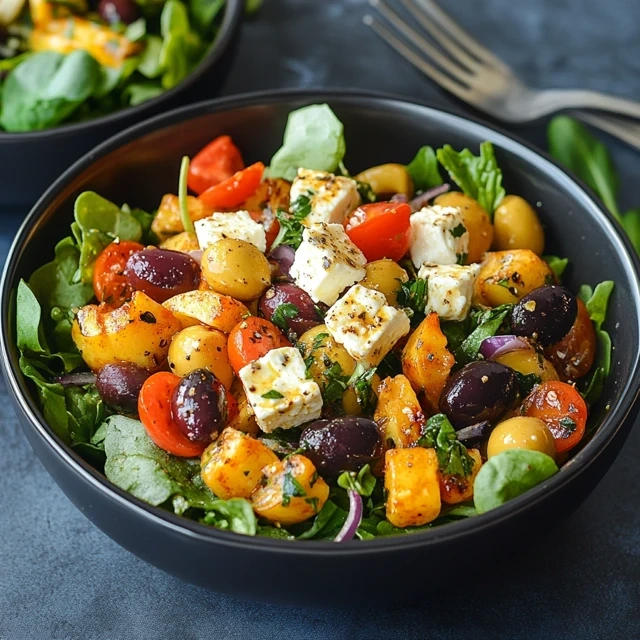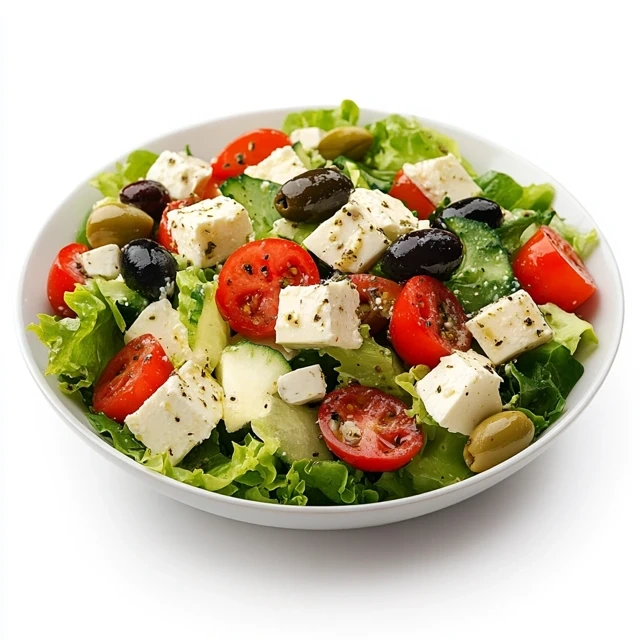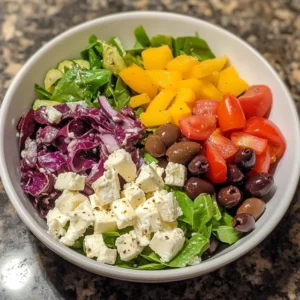Ever wondered why a Greek salad with feta and olives is so special? It’s more than just veggies. It’s a journey through Mediterranean cuisine, full of flavor in every bite.
Picture a salad that’s full of life, with fresh veggies, tangy feta, and rich olives. The Greek salad is simple yet elegant. It brings Greece’s sunny vibes right to your table.
Every ingredient has a story. From the juicy tomatoes to the crumbled feta, this salad celebrates Mediterranean cooking. It turns simple ingredients into a memorable dining experience.
Key Takeaways
- Discover the authentic flavors of Mediterranean cuisine
- Learn the art of creating a perfect Greek salad
- Explore the rich cultural significance of traditional ingredients
- Understand the balance of fresh vegetables and cheese
- Uncover the simplicity of Mediterranean cooking
What Makes an Authentic Greek Salad Special
Greek salad is a key part of Mediterranean cuisine, known for its fresh ingredients. It’s more than just a mix of veggies; it’s a journey through Greek culture.
This salad has deep roots in Greece’s farming history. Farmers and cooks created a recipe that highlights local produce and simple cooking.
Origins of Traditional Greek Salad
Traditional Greek salad comes from rural areas where food was fresh. People would mix:
- Ripe tomatoes from local gardens
- Crisp cucumbers
- Tangy feta cheese
- Robust Kalamata olives
Key Components of Authenticity
Authentic Greek salad uses top-notch, fresh ingredients. The Mediterranean way is simple, letting natural flavors speak for themselves.
Cultural Significance in Mediterranean Cuisine
This dish is about more than food; it’s about community and sharing meals. It shows the Greek way of eating: fresh, social, and connected to the land.
Essential Ingredients for Your Perfect Greek Salad
To make a real Greek salad, you need the right ingredients. They should add vibrant flavors and textures. Each part is important for a memorable dish.
Start with fresh vegetables. Ripe tomatoes are sweet and tangy. Crisp cucumbers add a refreshing crunch. Thinly sliced red onions bring a sharp, aromatic flavor.
- Tomatoes: Choose ripe, red tomatoes for maximum flavor
- Cucumber: Select firm, dark green cucumbers
- Red onion: Thinly slice for a zesty kick
- Kalamata olives: Authentic Greek variety with rich, briny taste
- Feta cheese: Creamy, tangy cheese that defines the salad
Kalamata olives make a Greek salad special. They add a deep, salty flavor that goes well with fresh veggies. Add authentic feta cheese for a true Greek taste.
| Ingredient | Ideal Characteristics | Flavor Profile |
|---|---|---|
| Tomatoes | Ripe, bright red, firm | Sweet, slightly acidic |
| Cucumber | Dark green, crisp, seedless | Cool, refreshing |
| Feta Cheese | Creamy, white, crumbly | Tangy, salty |
| Kalamata Olives | Deep purple, plump | Rich, briny, intense |
Choose fresh, high-quality ingredients. Opt for local produce and authentic Greek feta. This will give your salad the best flavor.
Selecting and Preparing Fresh Vegetables

Making a great Greek salad begins with picking the best vegetables. The quality of your tomatoes and cucumbers is crucial. They can turn a simple salad into a true Mediterranean delight.
Choosing Ripe Tomatoes and Crisp Cucumbers
Here’s what to look for in tomatoes for your Greek salad:
- Deep, vibrant red color
- Firm but slightly soft when gently squeezed
- Sweet, fragrant aroma
- No blemishes or bruising
For cucumbers, aim for these traits:
- Bright green and glossy
- Firm to the touch
- Medium-sized with minimal seeds
- Free from soft spots or wrinkles
Proper Cutting Techniques
To get your tomatoes and cucumbers ready for a traditional Greek salad, follow these steps:
- Wash vegetables thoroughly under cool water
- Pat dry with clean paper towels
- Cut tomatoes into rough chunks about 1-inch square
- Slice cucumbers into half-moon shapes approximately 1/4 inch thick
Vegetable Storage Tips
To keep your tomatoes and cucumbers fresh, follow these tips:
- Store tomatoes at room temperature away from direct sunlight
- Keep cucumbers in the refrigerator’s crisper drawer
- Use fresh vegetables within 2-3 days of purchase
- Avoid storing tomatoes and cucumbers together, as they have different optimal storage conditions
By choosing, preparing, and storing your tomatoes and cucumbers right, you’ll have a crunchy, tasty base for your Greek salad.
The Art of Choosing Quality Feta Cheese
Finding the right feta cheese can make your Greek salad amazing. Not all feta is the same. Knowing the differences will help you make a true Mediterranean dish.
Real feta cheese has a special label. It must be made in certain areas of Greece. When you’re shopping, look for these signs:
- Crumbly yet creamy texture
- Bright white color
- Tangy, slightly salty flavor profile
- Made from sheep’s milk or a blend of sheep and goat’s milk
Your feta should taste rich and complex. It should not overpower your salad. Greek PDO (Protected Designation of Origin) feta is the best quality. These cheeses are made the old way in places like Thessaly, Macedonia, and Thrace.
Here are some tips for buying feta for your salad:
- Check the label for Greek origin
- Opt for cheese stored in brine for maximum freshness
- Avoid pre-crumbled feta, which loses flavor quickly
- Buy from specialty cheese shops or reputable grocers
It’s important to store feta cheese right. Keep it in the fridge in its brine or salt water. This keeps its taste and texture. Let the cheese warm up to room temperature before adding it to your salad.
Greek Salad with Feta And Olives: Step-by-Step Guide
Making the perfect greek salad with feta and olives is simple. It needs fresh ingredients and a few basic steps to highlight its flavors.
To make a real greek salad, pick the right ingredients and assemble them carefully. Here’s how to do it step by step.
Preparation Time and Serving Size
Your greek salad will be ready in about 15 minutes. It serves 2-4 people, perfect as a side or main dish.
- Total prep time: 15 minutes
- Servings: 2-4 people
- Difficulty level: Easy
Assembly Instructions
- Wash and chop fresh vegetables
- Cut crisp cucumbers into chunks
- Slice ripe tomatoes
- Dice red onions thinly
- Crumble high-quality feta cheese
- Add kalamata olives
Presentation Tips
Presenting your greek salad is key. Place each ingredient in a shallow bowl to show off its beauty.
- Use a white or light-colored serving dish
- Layer ingredients strategically
- Drizzle olive oil generously
- Sprinkle dried oregano on top
Pro tip: Serve your greek salad right away for the best taste and texture.
Mastering the Perfect Vinaigrette Dressing

Making a great vinaigrette dressing can take your Greek salad to the next level. The secret is using top-notch extra virgin olive oil and finding the perfect mix of ingredients.
Start with the best extra virgin olive oil for your vinaigrette. This key ingredient adds deep flavor and a true Mediterranean taste to your salad. Choose cold-pressed olive oils for their strong, fresh flavors.
- Choose extra virgin olive oil with a vibrant, peppery taste
- Select fresh, high-quality red wine vinegar
- Include dried oregano for traditional Greek flavor
- Add a pinch of sea salt and freshly ground black pepper
The right vinaigrette dressing needs the right mix. A classic mix is three parts extra virgin olive oil to one part red wine vinegar. This mix brings together the flavors of your salad’s crisp veggies and tangy feta cheese.
To get the dressing just right, whisk your ingredients well or shake them in a jar. Shake until the oil and vinegar mix smoothly. Then, taste and tweak the seasoning to get a bright, zesty flavor.
Pro tip: Make your vinaigrette at least 30 minutes before you serve it. This lets the flavors blend, making the dressing richer and more complex.
Kalamata Olives: Selecting and Serving
Kalamata olives are a true treasure in Greek cooking. They come from the Peloponnese region of Greece. These dark purple olives add a rich, fruity taste to any dish.
Learning how to pick, store, and serve kalamata olives can make your cooking better.
Exploring Greek Olive Varieties
Greek olives are amazing, but kalamata olives are extra special. They are almond-shaped and have a deep purple to black color. They also have a smooth texture and a wine-like flavor.
They even have a Protected Designation of Origin (PDO) status.
Proper Storage and Handling
Keeping kalamata olives fresh is important. Store them in a cool, dark spot or in the fridge in their brine. Always use clean tools when handling them to avoid contamination.
When buying from an olive bar, look for plump, shiny olives.
Here are some tips for using kalamata olives in your cooking:
- Rinse them briefly to cut down on saltiness
- Pat them dry with paper towels
- Decide whether to slice or leave them whole, depending on your recipe
- Add them towards the end of cooking to keep their flavor
Whether you’re making a classic Greek salad or trying out new Mediterranean recipes, kalamata olives will add real flavor and nutrition to your meals.
Health Benefits of Mediterranean Ingredients
Your Greek salad is more than just tasty. It’s a nutritional powerhouse with amazing health benefits. The Mediterranean diet is known for its focus on wellness through the right ingredients.
The veggies in a Greek salad are full of nutrients. Tomatoes have antioxidants like lycopene, which is good for your heart and might lower cancer risks. Cucumbers help keep you hydrated and support healthy digestion.
- Feta cheese brings high-quality protein and calcium
- Olive oil contains heart-healthy monounsaturated fats
- Kalamata olives provide beneficial omega-3 fatty acids
This mix of ingredients gives you a balanced diet. Each part adds its own health benefits. So, the Greek salad is not just a side dish. It’s a smart choice for your nutrition.
Studies show the Mediterranean diet can help you live longer and prevent diseases. By eating this vegetarian dish, you’re not only enjoying a meal. You’re also investing in your health for the long term.
It’s good for reducing inflammation, improving heart health, and boosting metabolism. Your body will appreciate the choice of such a nutrient-rich meal.
Seasonal Variations and Adaptations

Your greek salad with feta and olives can change with the seasons. This shows the lively spirit of Mediterranean cuisine. With each season, you can enjoy new flavors in this classic dish.
The beauty of a great greek salad is its ability to adapt. You can change ingredients based on the season. Yet, it always keeps its core essence.
Summer Ingredient Celebration
Summer brings the freshest ingredients for your greek salad. In these warm months, focus on:
- Ripe, juicy tomatoes straight from the garden
- Crisp cucumbers with bright green color
- Fresh herbs like mint and oregano
- Peak-season bell peppers
Winter Ingredient Adaptations
When summer produce is scarce, you can still make a tasty greek salad. Just make smart substitutions:
- Roasted red peppers instead of fresh
- Preserved or jarred tomatoes
- Hearty winter greens like kale
- Pickled vegetables for extra tang
Regional Flavor Explorations
Mediterranean cuisine loves regional diversity. Greece has many unique greek salad variations:
- Cretan Style: Adds capers and uses local mountain herbs
- Thessaloniki Variation: Incorporates more robust olive varieties
- Island Interpretations: Often include fresh seafood elements
By exploring seasonal and regional flavors, your greek salad stays exciting and true to its roots all year.
Serving Suggestions and Pairing Options
Your Greek salad can become the main attraction with the right serving tips. Learning how to present and pair it will make your meal better.
For a full Mediterranean meal, try these great pairings:
- Grilled proteins like chicken souvlaki or lamb kebabs
- Warm pita bread with tzatziki sauce
- Seafood dishes such as grilled octopus or baked fish
Drinks can really bring out the flavors of your Greek salad. White wines and crisp rosés go well with the tangy feta and fresh veggies.
| Meal Setting | Recommended Pairings |
|---|---|
| Casual Lunch | Grilled chicken, pita chips |
| Dinner Party | Lamb chops, Assyrtiko wine |
| Light Dinner | Hummus, grilled vegetables |
Pro tip: Serve your Greek salad at room temperature. This lets the olive oil and fresh ingredients really stand out. It makes for a great dining experience.
Common Mistakes to Avoid When Making Greek Salad
Making the perfect Greek salad with feta and olives needs careful attention. Many home cooks make mistakes that ruin the dish’s flavor and texture. This is a classic Mediterranean dish.
Making a great Greek salad is more than just tossing ingredients. Knowing common mistakes helps improve your cooking. This way, you can make a dish that everyone will remember.
Ingredient Selection Errors to Watch Out For
- Choosing low-quality feta cheese that lacks authentic flavor
- Overusing red onion, which can overpower other ingredients
- Selecting underripe or overripe tomatoes that diminish the salad’s freshness
- Using dried herbs instead of fresh herbs
Assembly and Seasoning Challenges
Preparing a Greek salad is more than just mixing. The right technique makes a big difference. It’s all about how you put it together.
| Common Mistake | Correct Approach |
|---|---|
| Mixing salad too early | Prepare just before serving to maintain vegetable crispness |
| Adding dressing too soon | Dress right before serving to prevent soggy vegetables |
| Incorrect salt application | Season lightly to enhance, not mask, natural flavors |
When using feta cheese, quality is key. Choose authentic Greek feta that’s creamy and tangy. Cut it into large chunks to keep its texture.
Pro tip: Let your Greek salad ingredients sit at room temperature for 15-20 minutes before serving. This lets flavors mix and makes the salad more vibrant and tasty.
Conclusion
Making a Greek salad with feta and olives is more than a recipe. It’s a dive into Mediterranean cuisine. You’ll turn simple ingredients into a vibrant, tasty dish that shows off traditional Greek cooking.
The secret to a great salad is using fresh, top-notch ingredients. You need ripe tomatoes, crisp cucumbers, the best feta cheese, and real Kalamata olives. By using the tips from this guide, you can make a classic Mediterranean dish at home.
Enjoy the simplicity of this famous dish. A Greek salad brings together amazing flavors and textures that can make any meal better. Try your own twists and explore Mediterranean cuisine’s rich traditions. Your taste buds will love the journey.
Want to wow your loved ones? Your homemade Greek salad with feta and olives is just a few ingredients away. Start now, enjoy the making, and relish every bite of this timeless favorite.
Free Body Calculator – Know Your Body
Wondering if your body is in a healthy range? Use our Free Body Calculator to find out if you’re fit, normal, or need a lifestyle change. Get personalized tips, calorie targets, and your ideal protein, carbs, and fat intake – all in seconds.
Try Free Body Calculator Now
Easy Greek Salad with Feta and Olives
Ingredients
- 2 cups cherry tomatoes halved
- 1 cucumber diced
- 1/2 red onion thinly sliced
- 1 green bell pepper chopped (optional)
- 1/2 cup Kalamata olives pitted
- 1/2 cup crumbled feta cheese
- 2 tbsp extra virgin olive oil
- 1 tbsp red wine vinegar or lemon juice
- 1 tsp dried oregano
- Salt and black pepper to taste
Instructions
- Prepare Vegetables: In a large bowl, combine cherry tomatoes, cucumber, red onion, green bell pepper (if using), and olives.
- Add Feta: Sprinkle crumbled feta over the vegetables.
- Make Dressing: In a small bowl, whisk together olive oil, red wine vinegar, oregano, salt, and pepper.
- Toss & Serve: Pour the dressing over the salad and toss gently. Serve immediately or chill for 15 minutes for more flavor.
Notes
- For extra flavor, add capers or a few fresh basil leaves.
- Make it a meal by adding grilled chicken, shrimp, or chickpeas.
- Keeps well in the fridge for up to 2 days (without dressing).

